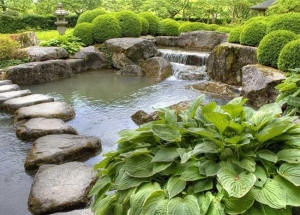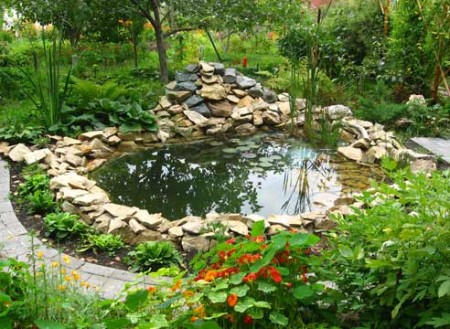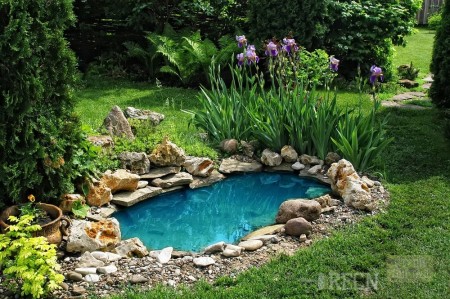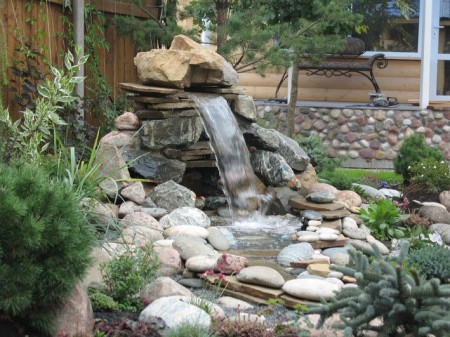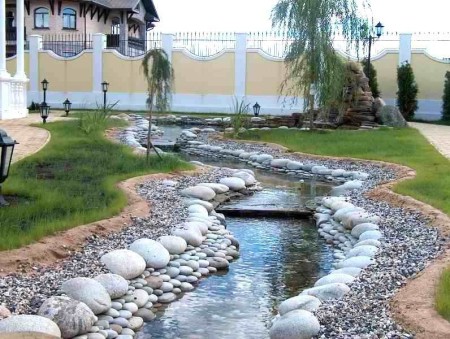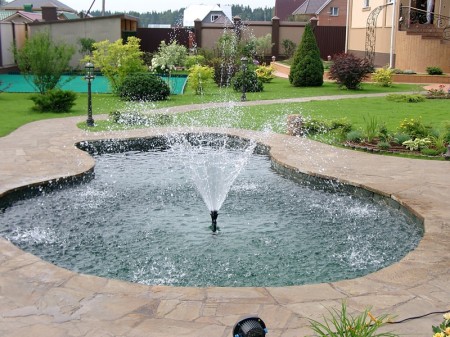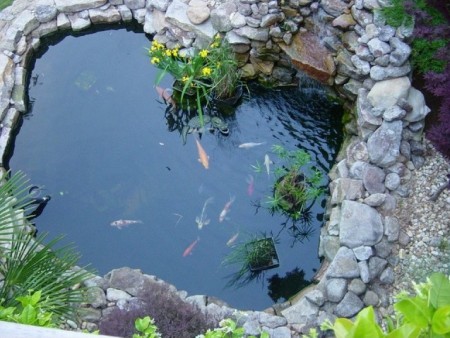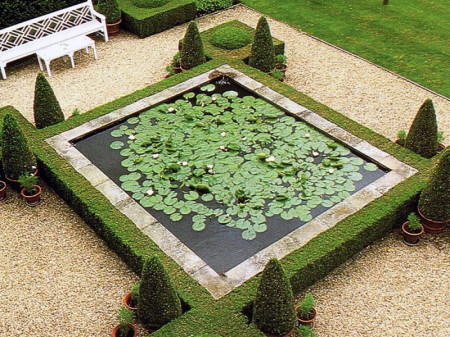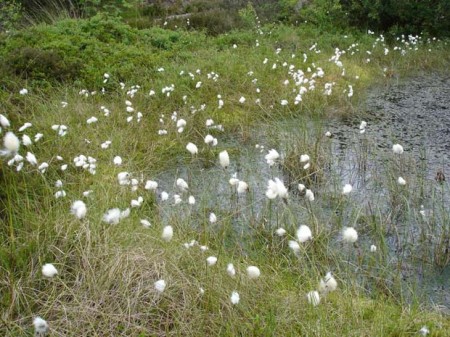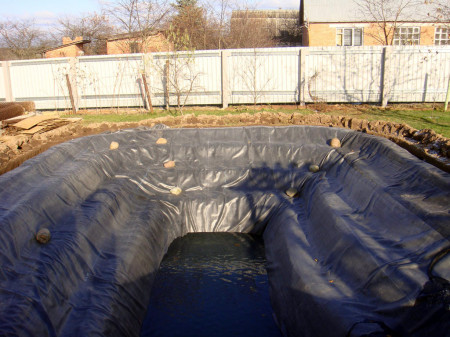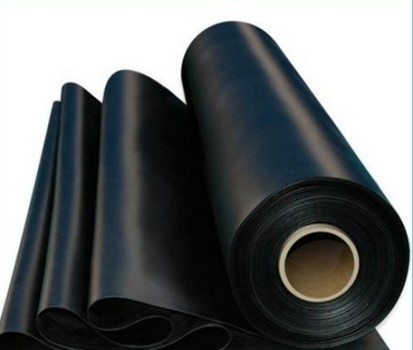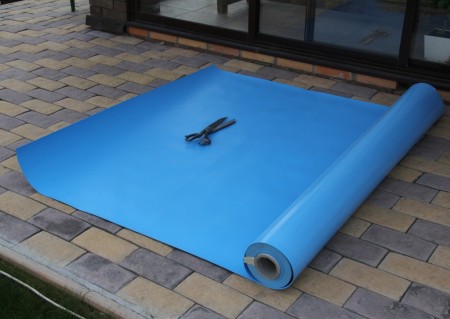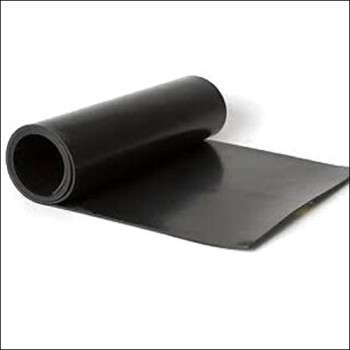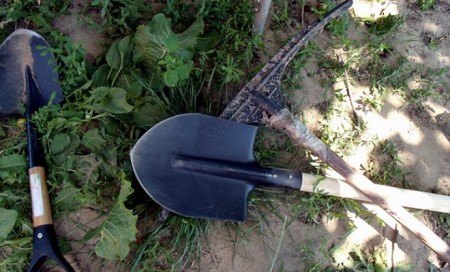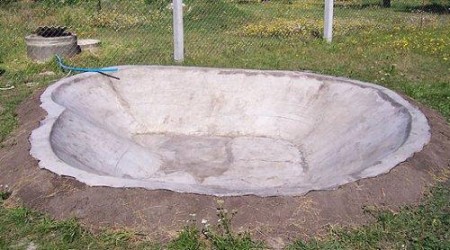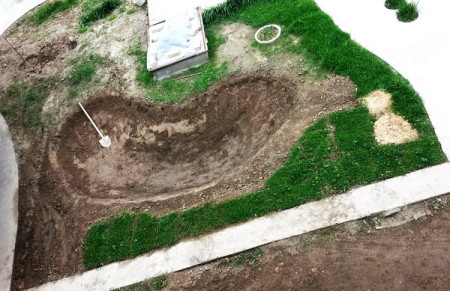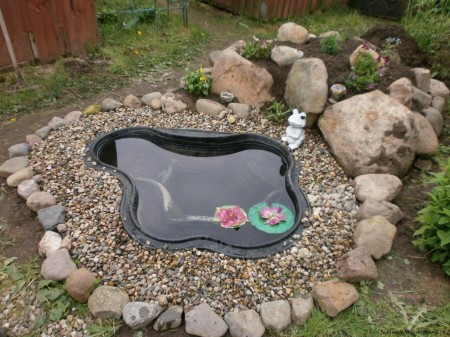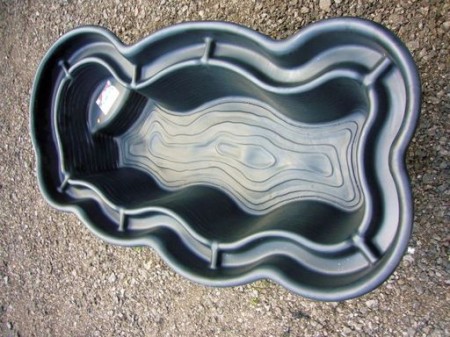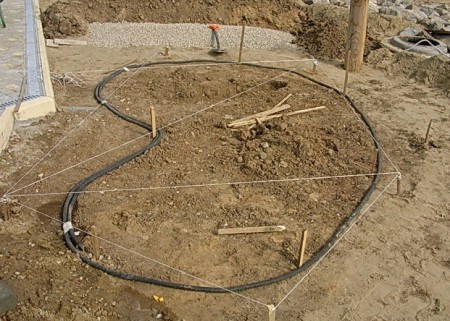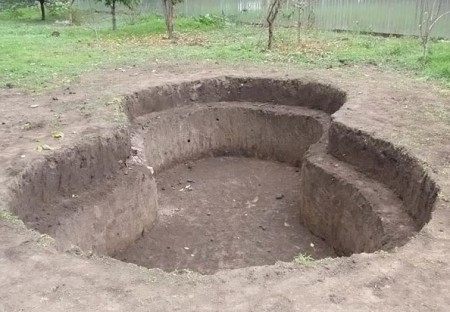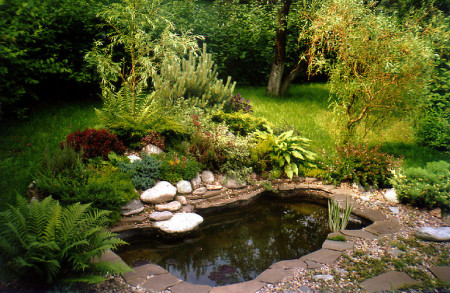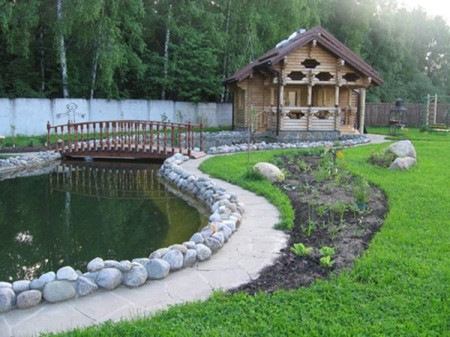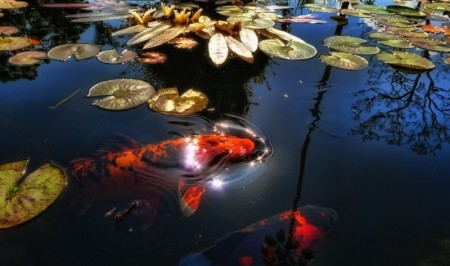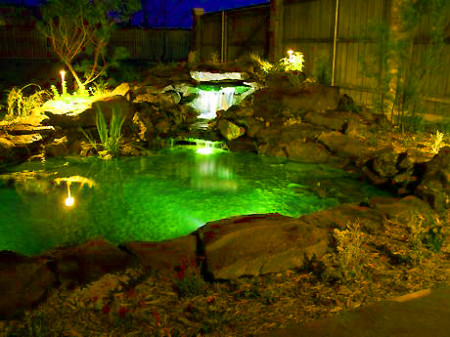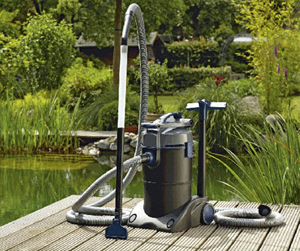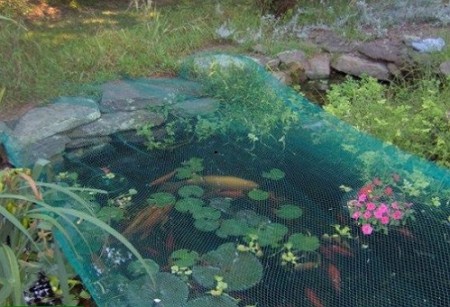Even the most dull and gray garden or country plot can be transformed, made interesting and cozy, if you make a small decorative pond on the territory. The pond fits into any landscape design, decorating it and visually expanding the space of the site.
Content
How to fit a decorative pond in the landscape of the site
Artificial pond on its own site is not only beautiful, but also practical. In the summer heat, even from a tiny pond, it is pleasantly cool and fresh, the air near it seems cleaner, and contemplation of the water surface helps to relieve stress and fatigue.
Most often on the territory of private plots, water bodies of the following types are arranged:
• Pond.
• Waterfall.
• Creek.
• Fountain.
Quite often they are combined, for example, by arranging a fountain in the middle of a pond, or a creek with a waterfall flowing into a pond. The shape of a decorative reservoir can be any, according to the taste of the owners - an irregular, arbitrary coastline, or a strict geometric form - a square, a rectangle, a rhombus, etc. It all depends on the general style in which the plot is drawn, from the site location, from personal preferences. The main thing that your pond does not look like a foreign body, and harmoniously fit into the landscape, was its integral part.
Most people choose the wrong, oval or rounded forms of the shoreline when choosing the shape of the future water body, because they are similar to the shape of natural water bodies. If you prefer this variant of design, then the "wrong" asymmetric planting of plants in the pond will also be appropriate.
When it is supposed to make a pond on the site, decorated in the classical style - with the right forms and straight lines, do not deviate from the style and make a pond of the right shape. Very often in such cases the reservoir plays the role of the base under the fountain, which is the main detail of the landscape.
Since water vegetation in such water bodies is usually not planted, the rims can be raised above the ground level, or make a small fence that will prevent the fall into the water. This is necessary if the family has small children.
Note that the simplest and cheapest option of an artificial reservoir on the site is a simple pond. Yes, and make a decorative pond in the country or a private plot on its own is not so difficult, as it might seem at first glance. The main thing in this business is to gain experience. And when he comes, who knows - maybe your pond will be the first in a chic complex with waterfalls, streams and fountains.
How to make a decorative pond yourself - where to start
So, the desire is there. But do not immediately grab the shovel and dig trenches. To begin with, you need to carefully and not hurry to find a place for a future reservoir. It should be located so that the whole area is illuminated most of the day by the sun. Otherwise, initially the beautiful lake will eventually turn into a swamp and beautiful "nursery" for mosquitoes.
The relief of the site is of great importance when choosing a place for a pond. Well, if it will be in the lowland, where the level of groundwater in the well or well is located closer to the surface. Pay attention to the vegetation near the pond - trees and bushes can greatly complicate your life, generously sowing the surface of the fallen leaves and branches, and expanding roots can easily damage the base of the reservoir.
The type of soil is also important. Best for equipping the pond is suitable loam, clay, peat soil. Worse - chernozem, as it contributes to the accumulation of silt at the bottom. If the soil is strongly acidic, it is necessary to make reliable protection of the walls and the bottom.
Once the site was identified, the shape and size of the pond are selected - the time to proceed with the selection and purchase of materials and tools. The easiest way to create a pond is to use ready-made containers, which can be bought at a specialized store. You can also cover the walls and the bottom with flexible waterproofing. Concrete bowls are used comparatively rarely due to high costs and high labor and time.
Which waterproofing is best used for an artificial pond.
• Simple polyethylene film - cheap, not resistant to sunlight material.
• High-pressure polyethylene (LDPE). At first glance, it does not differ from ordinary film, but it is more durable and flexible.
• Polyvinyl chloride (PVC). High-quality durable material. PVC sheets need to be welded together.
• Butyl and rubber sheets are the most suitable materials for the creation of a pond, the service life is unlimited, but not everyone can afford it.
If you want the pond to last a long time, do not use conventional polyethylene film - although it is more or less coping with its task, but it will last no more than 2 years.
Necessary materials and tools for work
Basic:
• The bayonet is bayonet and shovel.
• Ready-made reservoir or waterproofing.
• Plastic pipes for water supply and drainage.
• Sand or geotextile.
• Gates.
Another way to equip the pond - the creation of a concrete bowl, we will not consider in the context of this article in view of its laboriousness and high cost.
Work begins with the marking of the site, after which the layer of turf is removed. Further we dig a pond. The walls of the pit should be slightly under the slope - gently sloping, not steep.
After that, if you plan to make a reservoir using a film, rather than a finished container, the bottom and walls of the pit are lined with waterproof material. If the clay is at hand, that's fine. It should be laid in several layers - the second layer is laid only after the first completely dry. Between layers of clay it is necessary to lay a polyethylene film. After that, the bottom is covered with a small layer of gravel or crushed rock. In this case, you need to remember - if you plan to plant water plants in the pond, then at the bottom leave grooves and fill them with soil.
To ensure that the water in the pond always remains fresh and clean, it must be flowing. Otherwise, the water quickly stagnates, turns green and begins to exude an unpleasant odor, becoming a breeding ground for mosquitoes and harmful microorganisms.
To water constantly circulating in the pond, you need to use two pipes: flow and drain. Accordingly, along the flow pipe, fresh water will flow into the pond, and through the waste water, to be discharged beyond its limits, for example, into the gutter.
How to install a plastic pond
It takes much less labor and time if you buy a ready-made plastic container for a pond. Sometimes they are also called "galoshes", since such containers are often made of black plastic, and even slightly resembles a real galosh in its shape.
However, there are plastic ponds of any shape and size, the choice is very large, and if you want, you can find the product suitable for you in the form and size, especially since they are not so expensive.
arrangement of a plastic pond
• Contour marking according to the shape of the container.
• Digging and trench preparation.
• Installation of the tank in the finished pit.
To properly mark the contour under the tank, it is installed on the ground and along the perimeter, vertically set wooden racks with an interval of about 40 centimeters. Reiki tie a string in the bottom - you get a ready-made contour of plastic container.
Then proceed to the excavation. In the process, do not rush, and try to fit the bottom and walls under the contour of the tank to avoid gaps.
The container is installed in the finished pit strictly horizontally, after which it is gradually filled with water. If there are small gaps between the walls of the pit and the reservoir, they are filled with sand.
If you plan to make a fountain in an artificial pond, all the necessary equipment for the pond needs to be purchased in advance. This includes the pump and special nozzles. All this is installed during the installation of the tank.
The final stage of the work is the design of an artificial pond. To do this, you need to properly decorate and decorate its shores. It all depends on your imagination. The Internet has a lot of options for the design of artificial reservoirs, you can also consult a professional landscape designer.
Ceramic tiles, natural stone, wood, pebbles, etc. are widely used to decorate water bodies. These materials mask the edges of the reservoir, making them very similar to the real shore. Decorative materials must be carefully fixed with cement mortar. If it is planned to build a fountain in the pond, all equipment - hoses, pump, valves should be hidden with tiles, stones or pebbles.
Then you can wake up the bottom of the pond in advance with washed sand, lay pebbles, and plant aquatic plants. Near the pond, you can break a small flower bed or plant a shrub. In addition, nothing prevents you from settling in the pond any living creature - a fish or several dwarf turtles.
And if, in addition to doing everything on the bottom of the backlight or installing on the water surface lanterns on solar panels, then you can create a truly delightful enchanting game of water and light.
How to care for a pond
To maintain an artificial pond in proper condition, it must be constantly taken care of. To begin with, it does not hurt to buy a special bottom "vacuum cleaner" to collect garbage.
When the leaves begin to fall off, the surface of the reservoir should be covered with a fine mesh net, so that the foliage does not clog the water.
Pisces living in the pond need fresh and clean water, so you need to periodically filter and refresh the water - ideally it should be flowing. To water is not green, it is periodically subjected to filtration, planted plants that actively release oxygen: elodea, bolotnik, hornwort. Well, when in an artificial pond water lilies or egg capsules grow - their broad leaves do not let sunlight and prevent overheating of water.
In conclusion, I would like to note that an artificial reservoir is one of the central elements of landscape design, and its creation must be approached with all seriousness. Then the result will undoubtedly be a long time to please you.


